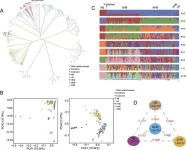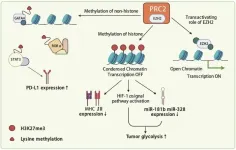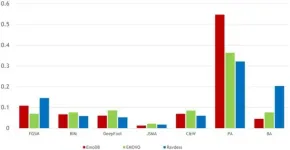(Press-News.org) August 9, 2024 — Analysis of men seen at a specialist clinic provides new insights into the classification of Peyronie's disease (PD) subtypes, according to a report in the September issue of The Journal of Urology®, an Official Journal of the American Urological Association (AUA). The journal is published in the Lippincott portfolio by Wolters Kluwer.
"By analyzing real-world clinical data in a large group of patients, we identified four distinct subtypes of PD, and additional categorization of other causes of penile curvature," comments Landon Trost, MD, of Male Fertility and Peyronie's Clinic in Orem, Utah. "We propose a new classification system, which we believe will provide a more consistent and standardized approach to classification and treatment of PD."
Evidence-based approach to Peyronie's disease classification
Peyronie's disease is a condition in which the penis becomes curved due to scar-like tissue called plaque. Some men experience pain, erectile dysfunction, or sexual dysfunction. Typically, PD is characterized by palpable plaque and curvature occurring in men in their fifties and sixties (The Urology Care Foundation has a Peyronie's disease fact sheet).
However, even in men with these "classical" findings, symptoms of PD may vary widely. Some men may develop a sudden curve, with no other symptoms, that remains stable over time; while others may experience ongoing pain and progression of the deformity. In the absence of more specific criteria, men with penile curvature of any cause are often diagnosed with PD.
To identify patterns and clinical subtypes of PD, Dr. Trost and colleagues analyzed clinical data on 1,098 men with confirmed penile deformity evaluated at the clinic from 2020 to 2023. In a second sample, secondary deformity or curvature was reported by 18 of 162 responding to a long-term follow-up survey.
Proposed system a 'notable advancement' in PD research and treatment
Statistical analysis of the data identified four distinct subtypes of PD: three "non-classical" subtypes defined by the presence of calcifications, progression (worsening curvature), or a relapsing/remitting pattern; and a "classical" subtype with none of these features. Men with classical PD had some distinct characteristics, including older age, more stable curvature, and fewer problems with pain.
In addition, the researchers identified three non-PD categories: congenital (lifelong), maturational (developing around puberty), and trauma-induced penile curvature. The progressive pattern was the most common finding, seen in 57% of patients. Classical PD and trauma-induced, non-PD penile curvature were each found in 27% of patients. (Some patients had overlapping subtypes, falling into multiple categories.)
Surprisingly, pain was not a reliable predictor for either progression or stability of the penile curvature. Analysis of follow-up data suggested that the distinction between stable and progressive PD can be made after three months' follow-up. Longer follow-up – at least six months – was needed to identify relapsing-remitting PD.
Dr. Trost and colleagues propose a "PTNM" classification system made up of four factors: the subtype of PD, history of trauma, non-PD subtype, and stable or active mode during follow-up. This system "allows for a more consistent and standardized method of classifying PD and communication among healthcare professionals."
"Pending external validation, these findings represent a notable advancement for the field of PD," the researchers add. They note that the patients in their study may not reflect the broader population of men with PD or non-PD penile curvature.
"We believe our proposed PTNM system will be clinically helpful in the evaluation and management of men with penile curvature," Dr. Trost comments. "This information has the potential to improve prognostic information, enhance patient counseling, and facilitate treatment decision-making for patients with PD, as well as guiding further research."
Read Article: Creation of a Novel Classification System (PTNM) for Peyronie's Disease and Penile Curvature Using Evidence-Based Criteria
Wolters Kluwer provides trusted clinical technology and evidence-based solutions that engage clinicians, patients, researchers and students in effective decision-making and outcomes across healthcare. We support clinical effectiveness, learning and research, clinical surveillance and compliance, as well as data solutions. For more information about our solutions, visit https://www.wolterskluwer.com/en/health.
###
About Wolters Kluwer
Wolters Kluwer (EURONEXT: WKL) is a global leader in information, software solutions and services for professionals in healthcare; tax and accounting; financial and corporate compliance; legal and regulatory; corporate performance and ESG. We help our customers make critical decisions every day by providing expert solutions that combine deep domain knowledge with technology and services.
Wolters Kluwer reported 2023 annual revenues of €5.6 billion. The group serves customers in over 180 countries, maintains operations in over 40 countries, and employs approximately 21,400 people worldwide. The company is headquartered in Alphen aan den Rijn, the Netherlands.
For more information, visit www.wolterskluwer.com, follow us on LinkedIn, Facebook, YouTube and Instagram.
END
'PTNM' System provides new classification for Peyronie's disease and penile curvature
Journal of Urology presents evidence-based approach to identifying penile curvature subtypes
2024-08-09
ELSE PRESS RELEASES FROM THIS DATE:
The molecular shield: how tea plants combat drought through protein phosphorylation
2024-08-09
A pivotal study has discovered a protein phosphorylation mechanism that plays a critical role in the negative regulation of flavonoid biosynthesis in tea plants (Camellia sinensis) during drought stress. This insight into the molecular response of tea plants to environmental stress could lead to the development of agricultural strategies to enhance crop resilience and quality preservation under water scarcity conditions.
Drought stress poses a significant challenge to agriculture, causing substantial yield losses in many crops. Tea plants, known for their rich flavonoid content ...
Spectral measurements capable of estimating nutrient content of forest tree leaves
2024-08-09
The general health of forests can be estimated by the micro- and macronutrient content of tree leaves to help inform forest management decisions in the light of climate change, species loss and other variables. Traditional methods of assessing nutrient levels in forests are expensive and labor-intensive. Researchers recently analyzed the reflected spectra from tree foliage to accurately estimate the nutrients of leaves, offering a faster, larger-scale method of assessing forest health.
Field methods of collecting leaf samples ...
Blueprint for blueberry improvement: genetic and epigenetic discoveries
2024-08-09
Recent research has uncovered significant genetic and epigenetic variations in blueberry cultivars, particularly between northern highbush (NHB) and southern highbush (SHB) blueberries. The study highlights gene introgression's role in SHB's adaptation to subtropical climates and identifies key genes, such as VcTBL44, associated with fruit firmness. These findings offer valuable insights and resources for future blueberry breeding.
Blueberries, part of the Vaccinium genus, are renowned for their nutritional benefits and increasing global demand. However, cultivation faces challenges like ...
The heightened importance of EZH2 in cancer immunotherapy
2024-08-09
Enhancer of zeste homolog 2 (EZH2) is a catalytic subunit of the Polycomb-repressive complex 2 (PRC2), which plays a crucial role in transcriptional repression through the methylation of histone H3 on lysine 27 (H3K27me3). This epigenetic modification leads to chromatin compaction and gene silencing. EZH2 is frequently overexpressed in a variety of cancers, including head and neck, breast, prostate, bladder, colorectal, lung, pancreatic, melanoma, and lymphoma. Mutations in the EZH2 gene are also prevalent in several hematological malignancies, such as B-lymphomas and follicular lymphomas. The dual role of EZH2 as both a tumor suppressor and oncogene depending on the cancer type ...
Researchers expose vulnerability of speech emotion recognition models to adversarial attacks
2024-08-09
Recent advancements in speech emotion recognition have highlighted the significant potential of deep learning technologies across various applications. However, these deep learning models are susceptible to adversarial attacks. A team of researchers at the University of Milan systematically evaluated the impact of white-box and black-box attacks on different languages and genders within speech emotion recognition. The research was published May 27 in Intelligent Computing, a Science Partner Journal.
The ...
Classical music lifts our mood by synchronizing our “extended amygdala”
2024-08-09
Whether Bach, Beethoven, or Mozart, it’s widely recognized that classical music can affect a person’s mood. In a study published August 9 in the Cell Press journal Cell Reports, scientists in China use brainwave measurements and neural imaging techniques to show how Western classical music elicits its positive effects on the brain. Their goal is to find more effective ways to use music to activate the brain in those who otherwise don’t respond, such as people with treatment-resistant depression.
“Our research integrates the fields of neuroscience, psychiatry, and ...
New technology uses light to engrave erasable 3D images
2024-08-09
Imagine if physicians could capture three-dimensional projections of medical scans, suspending them inside an acrylic cube to create a hand-held reproduction of a patient's heart, brain, kidneys, or other organs. Then, when the visit is done, a quick blast of heat erases the projection and the cube is ready for the next scan.
A new report in the journal Chem by researchers at Dartmouth and Southern Methodist University (SMU) outlines a technical breakthrough that could enable such scenarios, and others with widespread utility.
The study introduces a technique that uses a specialized ...
How did mental health parity laws affect new moms?
2024-08-09
Pregnant and postpartum women with depression and anxiety have a slightly better chance of getting psychotherapy these days, a new study finds. And they are paying less of their own money when they do.
The changes in care and cost happened mainly after the Affordable Care Act took effect in 2014, and to a lesser extent after the Mental Health Parity and Addiction Equity Act, or MHPAEA, took effect in 2010, the analysis shows.
Both laws aimed at reducing insurance-related barriers to mental health care.
Even so, only about 10% of women with private insurance ...
Universal free school meals and school and student outcomes
2024-08-09
About The Study: In this systematic review, universal free school meals were associated with increased meal participation, no or slight improvements in attendance, and decreased obesity prevalence and suspension rates; certainty of evidence was moderate for lunch participation and low or very low for other outcomes. Studies did not report several important outcomes, such as diet quality and food security, suggesting the need for more high-quality research encompassing policy-relevant indicators.
Corresponding Author: To ...
Researchers crack a key celiac mystery
2024-08-09
People with celiac disease must navigate everyday life by avoiding gluten, a protein in wheat, rye and barley which can trigger painful symptoms in the gut, impede the absorption of nutrients and raise the risk of other serious long-term issues.
The autoimmune disorder affects about 1 per cent of the population. Its rate of occurrence has roughly doubled in the past 25 years, but there is no treatment available.
An interdisciplinary team of medical and engineering researchers centred at Canada’s McMaster University and including colleagues from the US, Australia, and Argentina, has spent the ...
LAST 30 PRESS RELEASES:
UVA’s Jundong Li wins ICDM’S 2025 Tao Li Award for data mining, machine learning
UVA’s low-power, high-performance computer power player Mircea Stan earns National Academy of Inventors fellowship
Not playing by the rules: USU researcher explores filamentous algae dynamics in rivers
Do our body clocks influence our risk of dementia?
Anthropologists offer new evidence of bipedalism in long-debated fossil discovery
Safer receipt paper from wood
Dosage-sensitive genes suggest no whole-genome duplications in ancestral angiosperm
First ancient human herpesvirus genomes document their deep history with humans
Why Some Bacteria Survive Antibiotics and How to Stop Them - New study reveals that bacteria can survive antibiotic treatment through two fundamentally different “shutdown modes”
UCLA study links scar healing to dangerous placenta condition
CHANGE-seq-BE finds off-target changes in the genome from base editors
The Journal of Nuclear Medicine Ahead-of-Print Tip Sheet: January 2, 2026
Delayed or absent first dose of measles, mumps, and rubella vaccination
Trends in US preterm birth rates by household income and race and ethnicity
Study identifies potential biomarker linked to progression and brain inflammation in multiple sclerosis
Many mothers in Norway do not show up for postnatal check-ups
Researchers want to find out why quick clay is so unstable
Superradiant spins show teamwork at the quantum scale
Cleveland Clinic Research links tumor bacteria to immunotherapy resistance in head and neck cancer
First Editorial of 2026: Resisting AI slop
Joint ground- and space-based observations reveal Saturn-mass rogue planet
Inheritable genetic variant offers protection against blood cancer risk and progression
Pigs settled Pacific islands alongside early human voyagers
A Coral reef’s daily pulse reshapes microbes in surrounding waters
EAST Tokamak experiments exceed plasma density limit, offering new approach to fusion ignition
Groundbreaking discovery reveals Africa’s oldest cremation pyre and complex ritual practices
First breathing ‘lung-on-chip’ developed using genetically identical cells
How people moved pigs across the Pacific
Interaction of climate change and human activity and its impact on plant diversity in Qinghai-Tibet plateau
From addressing uncertainty to national strategy: an interpretation of Professor Lim Siong Guan’s views
[Press-News.org] 'PTNM' System provides new classification for Peyronie's disease and penile curvatureJournal of Urology presents evidence-based approach to identifying penile curvature subtypes






